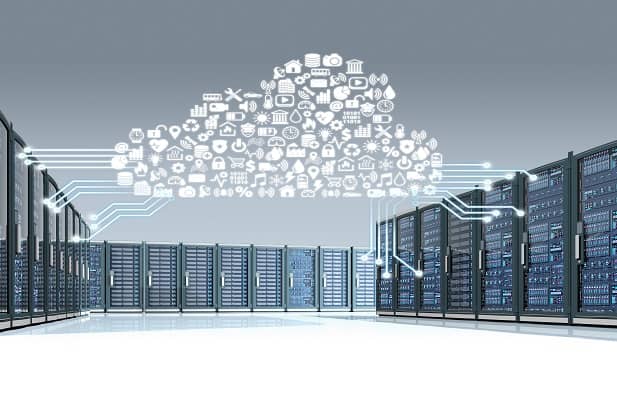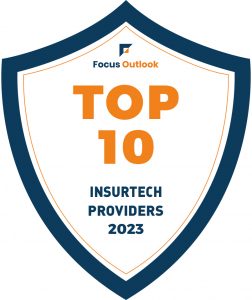Cloud technology is rapidly expanding its feet in every industry. With such extensive usage arises a need for more rigorous monitoring and governance to ensure security and reliability.
Cloud monitoring tools helps businesses track their reaction times, asset utilization, accessibility, execution, security, and more. It helps handle issues before they spiral out of control, ensuring the scalability and agility of businesses. Diligent monitoring of the health of their cloud-based applications and infrastructures benefits enterprises with the following:
- Higher productivity and reduced disturbance
- Real-time updates and alerts
- Safer operations
- Enhanced performance and customer satisfaction
Table of Contents
Cloud Monitoring Tools
Every cloud implementation has several moving parts. Cloud monitoring tools track these parts, including cloud services, operations, resources, and performance areas. The best cloud monitoring tools must include customized metrics to meet an organization’s specific needs. Monitoring tools deliver multifold benefits.
- Holistic tracking of infrastructure and application health from organization to transaction and code-level
- Scalable monitoring with growing scope and infrastructure
- Cost-effective solution with flexible payment models
- Proactive and predictive resolution with data-driven, real-time alerts
- Remote and dynamic environment monitoring
- Secured and superior customer experience
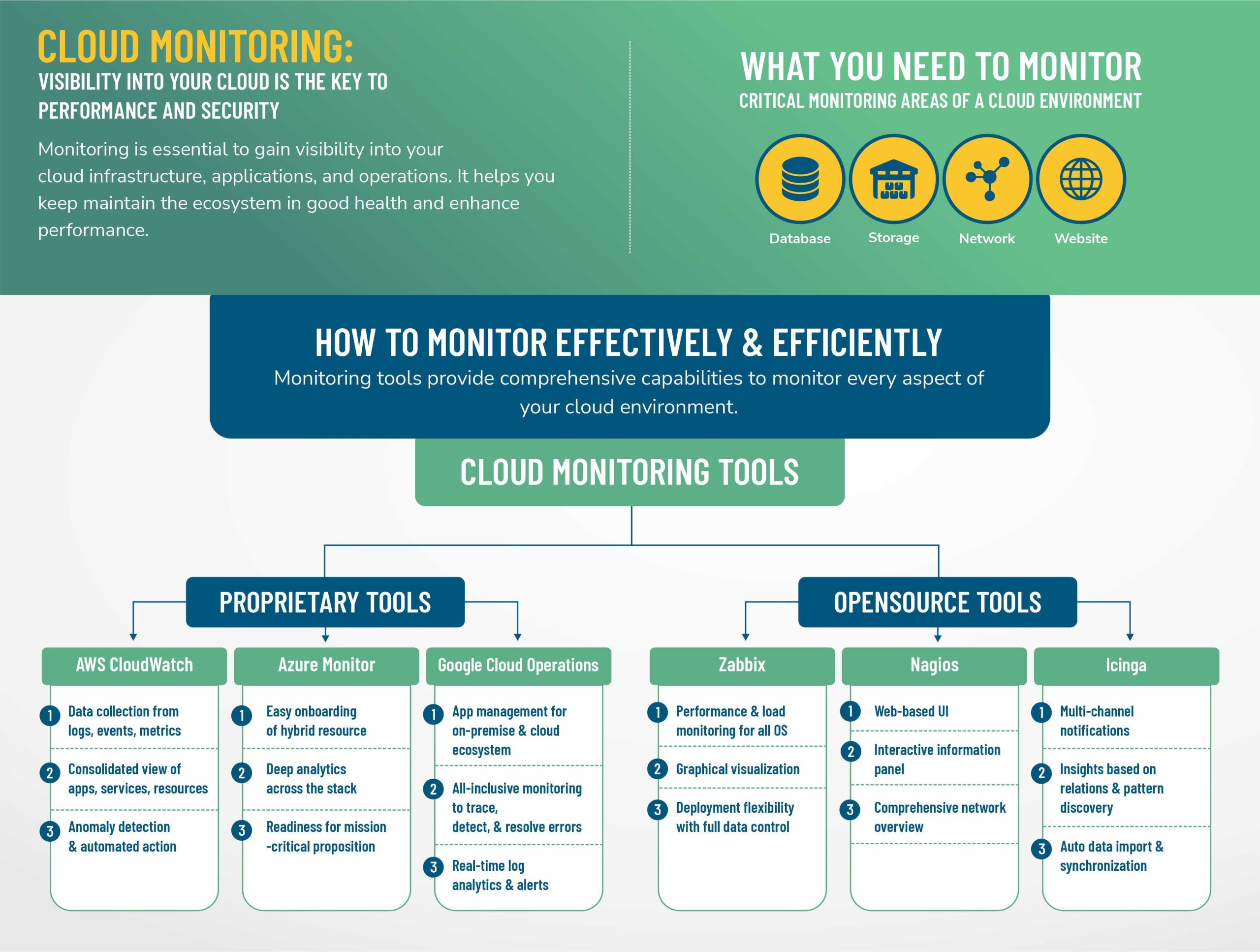 Critical cloud monitoring areas
Critical cloud monitoring areas
- Database: Database monitoring tracks processes, queries, consumption, and availability of database resources that the cloud offers. It assesses real-time data usage to ensure integrity and security.
- Storage: Storage monitoring reviews applications, databases, services, and virtual machines for their provisioned resources and processes. It is pervasive in hosting IaaS and SaaS solutions.
- Virtual Network: Virtual network monitoring creates software versions of network components (routers, load balancers, and firewalls). These components are adjusted to restore the network’s health if an issue is detected instead of swapping physical components.
- Website: A website is a set of files hosted locally. This aspect of monitoring tracks all the processes, resource utilization, traffic, and availability of the cloud-hosted website files.
Some popular cloud monitoring tools
AWS CloudWatch
AWS CloudWatch cloud monitoring tool provides users with a unified view of overall operational health. It delivers actionable insights for application monitoring, resource utilization optimization, and responding to system-wide changes in performance. Users get:
- Collection of operational data from logs, events, and metrics
- Consolidated view of applications, services, and resources running on on-premises and AWS
- Anomaly detection and automated actions to troubleshoot issues
Pros
- It is native to the AWS ecosystem, making it easier to set up and run
- Simple settings for rules and alarms
- Filter and track all incoming requests
Cons
- Complex dashboards and user interfaces
- Maintaining and querying logs at scale gets difficult
- Alerts for unusual IP addresses need improvement
Azure Monitor
Azure Monitor cloud monitoring tool is an Azure-native solution that collects data and metrics from logs and metrics from resources. It monitors performance, derives insights, creates dashboards, triggers alerts, and troubleshoots issues. Its key features are:
- Easy onboarding of Azure and hybrid resources
- Delivers deep insights at all levels across the stack
- Enable readiness for mission-critical propositions
Pros
- Live dashboards with a comprehensive resource view
- Quick alerts and notifications
- Open and extensible platform with single-pane visualization to facilitate innovation
Cons
- Lacks feature to monitor serverless applications
- Lacks facility for monitoring business activities
- Limited support for notification channels
Google Cloud Operations
Google Cloud Operations cloud monitoring tool, formerly known as Stakedriver, tracks live applications for code-level analysis and error resolution and facilitates mid-production performance optimization and testing. Its prominent features are:
- Application management on on-premises and cloud infrastructure
- Comprehensive monitoring with tools for error tracing, detection, and resolution
- Real-time log analysis and alerts
Pros
- Single-pane reporting of all application error
- Fully managed and highly scalable
- Easy to set up and use
Cons
- Searching for older logs is slower
- Limited default log availability (30 days)
- Graphical representation of data is missing
Opensource Cloud Monitoring Tools
Zabbix
Zabbix is a comprehensive cloud monitoring tool that provides all insights in a single-glass-pane view. It tracks everything: network, server, cloud, applications, and services. Businesses benefit from:
- Performance and load monitoring through agents supported by almost all OSs
- Easy-to-comprehend graphical visualization
- Deployment flexibility (on-premises and clouds) with complete data control
Pros
- Unlimited scalability and high availability
- Distributed tracking with central web UI and inter-component encryption
- Stringent security for sensitive information
Cons
- Agents need constant running resources to monitor servers and workstations
- Requires Additional computing for accessing monitoring data
- Lack of resilience
Nagios
Nagios, an industry standard for Information Technology (IT) infrastructure monitoring, tracks computer systems and networks. It monitors and controls computing nodes and servers and triggers alerts when a service stops or restores. It delivers:
- Easy-to-navigate web-based UI
- Interactive information panel
- All-inclusive overview of network devices, hosts, and servers
Pros
- A simple configuration, achievable for non-programmers
- Third-party plugin support for all situations
- Supports multiple utilities that represent Nagios and RRD data graphically
Cons
- No web interface for configuration
- Long delays between parameter measuring and testing
- Scaling without third-party plugins is complicated
Icinga
Icinga is a network monitoring solution that tracks all cloud ecosystem components’ performance, availability, and trends. It allows monitoring of public, private, and hybrid cloud environments independent of the provider. Its highlight features are:
- On-time notifications through multiple channels
- Deep insights based on relations and pattern discovery
- Automated data import and synchronization
Pros
- Easy-to-manage and intuitive dashboard
- Incredible scalability
- Simple yet powerful configuration
Cons
- Dashboard decluttering gets overwhelming
- Lacks area-wise, client and environment segregation
- Non-Unix users’ learning curve can be difficult
Governance Tools
Companies that run services in the cloud define a set of rules and policies for smooth operations. These rules focus on enforcing governance across the infrastructure to manage risks and enhance data security. Cloud technologies fuel innovation and productivity. However, it also opens the door to several issues, such as:
- Poor cloud system integration
- Redundant and inconsistent data in different organization parts
- Misaligned cloud implementation and business goals
- New security threats
Cloud governance properly plans, considers, and manages all aspects of cloud computing, from system integration to asset deployment and data security. Organizations running critical services on the cloud draw several benefits from cloud governance.
- System segregation into accounts representing the organization’s projects, departments, and cost centers to improve visibility, cost control, and protection against security threats
- Prevention from shadow IT by providing convenient access to cloud resources within the organization’s visibility and control
- Centralized definition and enforcement of organization policies
- Centralized cost and access control, alerts, and responses to violations
- Protection of information’s integrity, availability, and confidentiality
- Visibility of sensitive information and appropriate security controls regardless of data location and critical systems deployment
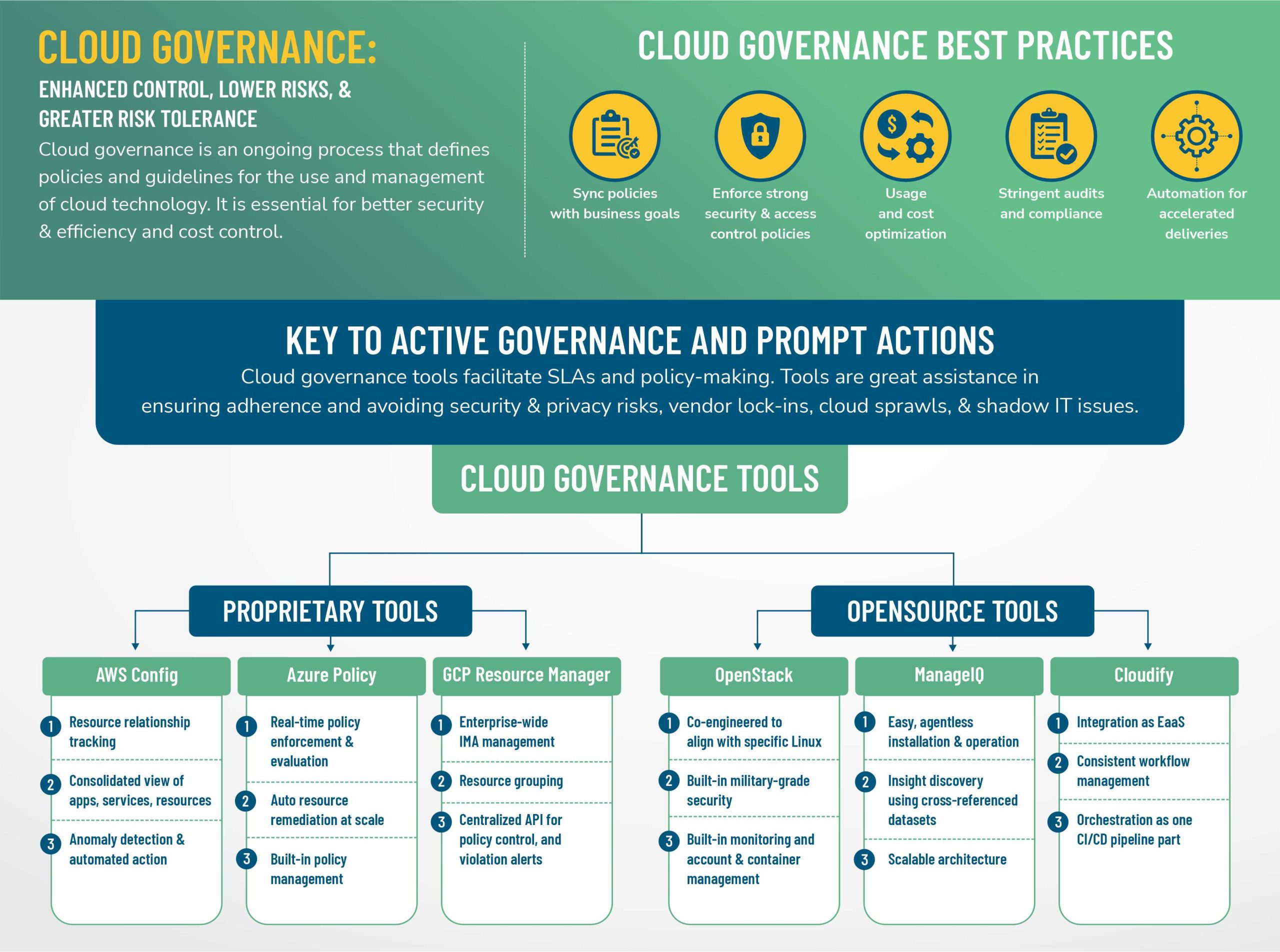 Here are the five cloud governance best practices to help organizations achieve agility and cost-saving benefits of cloud implementations.
Here are the five cloud governance best practices to help organizations achieve agility and cost-saving benefits of cloud implementations.
- Aligning cloud governance policies with business goals
- Building and enforcing strong security and access management policies
- Optimizing resource usage and overall cost
- Emphasizing audits and compliance
- Deploy automation for accelerated deliveries
Some popular cloud monitoring tools
AWS Config
AWS Config creates a detailed resource inventory that records every resource’s creation, deletion, and change. It retrieves current and historical configurations, evaluates them for the desired settings, and sends notifications for every modification. It facilitates robust governance by:
- Tracking resource relationship
- Customizable and configurable rules
- Multi-region, multi-account data aggregation
Azure Policy
It helps in organizational standard enforcement and compliance assessment at scale. Azure Policy provides an aggregated view of the environment through the dashboard drilled down to per-resource, per-policy granularity. It facilitates organizations for:
- Real-time enforcement and evaluation of policies
- Automated remediation of current and new resources at scale
- Security and compliance at scale through built-in policy management
GCP Resource Manager
Resource Manager allows the sorting of resources hierarchically. It maps organizational structure to the cloud and manages access and permissions for the lower-level resources (App Engines, VMs, Storage Buckets, etc.). Its prominent features include:
- IMA management across the enterprise
- Resource grouping using containers viz. project, folders, and organizations for hierarchical organization
- Policy creation, control, and violation alerts on centralized APIs
Opensource Cloud Monitoring Tools
OpenStack
OpenStack provides APIs and dashboards to govern a pool of networking, computing, and storage resources. Beyond standard IaaS features, it allows orchestration, service, and fault management. Some highlights are:
- Co-engineered OpenStack to align with specific Linux
- Built-in military-grade security for private and public clouds
- Built-in utilities for account management, container management, and monitoring
ManageIQ
ManageIQ connects with all resources and management systems to discover inventory, identify changes, and map relationships. This self-service governance tool also captures metrics from various resources, understands their utilization, and optimizes. It empowers cloud governance by:
- Easy, agentless installation and operation
- Insight discovery using cross-referenced datasets from VMs, hosts, and containers using SmartState analysis
- Scalable architecture that allows standalone deployment or as a part of a global system
Cloudify
Cloudify is a multi-cloud and edge orchestration platform that bridges the gap between cloud environments and applications. It enables an effortless transition from public cloud architecture to cloud-native by allowing their side-by-side existence. It delegates the following features:
- EaaS empowering integration of all cloud ecosystems and current toolchains
- Consistent management of workflows across all infrastructure domains
- Management of different automation and orchestrations as one Ci/CD pipeline parts
Conclusion
Cloud frameworks are highly dynamic and have multiple operational and service delivery variables. They foster incredible benefits to enable agility and innovation. However, continuous evaluation of response time and resource levels is crucial to make the most of these benefits.
Cloud monitoring and governance provide a comprehensive view of all the cloud resources and allow defining and deploying role and activity-based policies across the infrastructure.
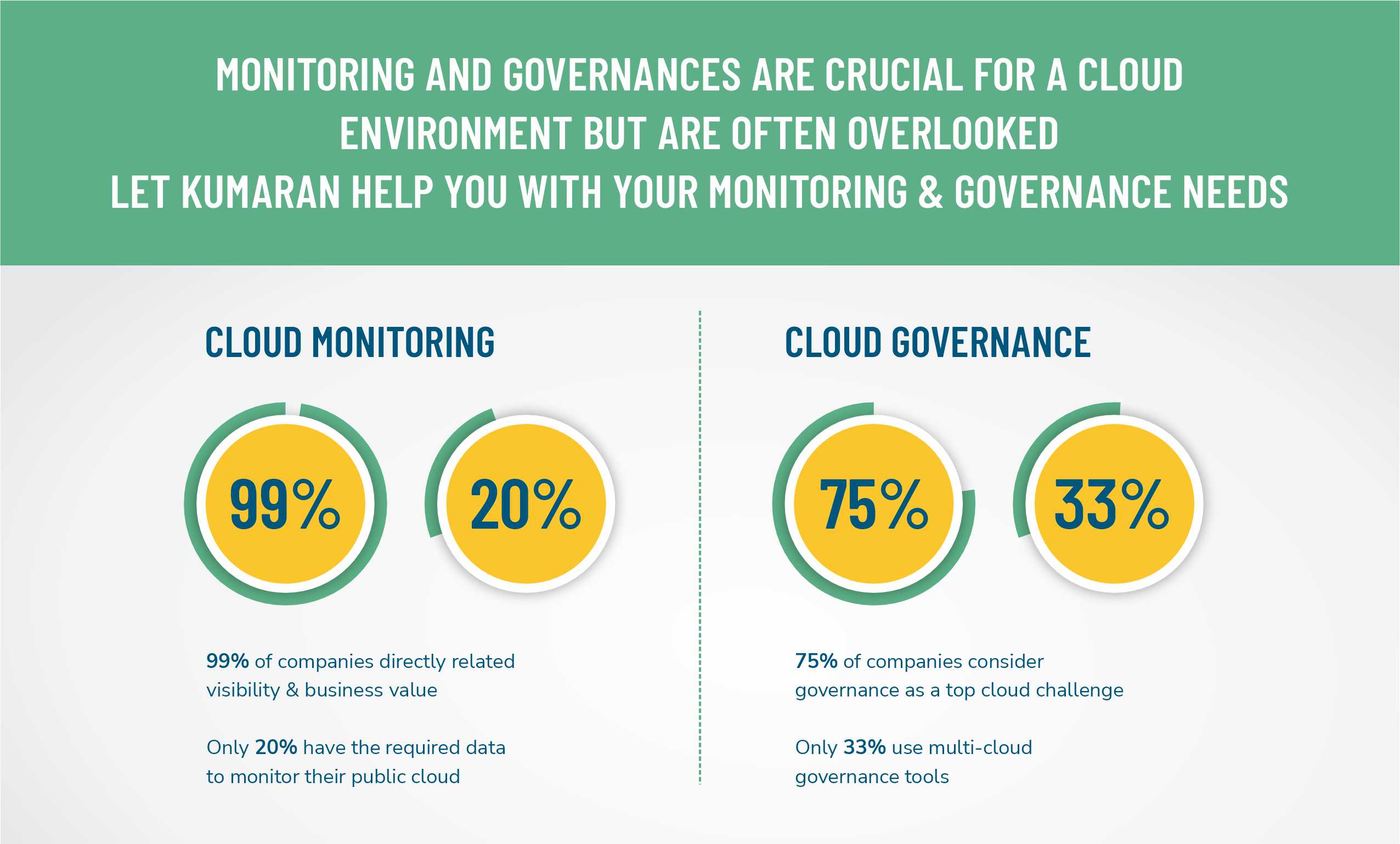 Kumaran Systems empower business leaders with all-inclusive monitoring and stringent governance to make more informed access decisions about their cloud-based services, detect risks and mitigate probability and impact effectively, ensuring application and infrastructure health. Talk to us to know more about the latest trends and customized solutions for your solution.
Kumaran Systems empower business leaders with all-inclusive monitoring and stringent governance to make more informed access decisions about their cloud-based services, detect risks and mitigate probability and impact effectively, ensuring application and infrastructure health. Talk to us to know more about the latest trends and customized solutions for your solution.

